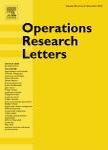版权所有:内蒙古大学图书馆 技术提供:维普资讯• 智图
内蒙古自治区呼和浩特市赛罕区大学西街235号 邮编: 010021

作者机构:Univ Toronto Dept Mech & Ind Engn Toronto ON Canada Texas Tech Univ Dept Ind Mfg & Syst Engn Lubbock TX 79409 USA Purdue Univ Sch Ind Engn W Lafayette IN USA Univ Toronto Inst Pandem Toronto ON Canada
出 版 物:《OPERATIONS RESEARCH LETTERS》 (运筹学快报)
年 卷 期:2024年第55卷
核心收录:
学科分类:1201[管理学-管理科学与工程(可授管理学、工学学位)] 07[理学] 070104[理学-应用数学] 0701[理学-数学]
基 金:We thank Dr. Proton Rahman (Eastern Health NL) and Dr. Randy Giffen (IBM Canada) for their help in building the morPOP agent-based simulation model for COVID-NL and for their expertise in COVID mitigation strategies. We also thank Newfoundland & Labrador Public Health for their guidance and data contributions to morPOP
主 题:The distance-based critical node detection problem Vaccination policies Mixed integer programming
摘 要:This paper proposes pandemic mitigation vaccination policies for Newfoundland and Labrador (NL) based on two compact mixed integer programming (MIP) models of the distance-based critical node detection problem (DCNDP). Our main focus is on two variants of the DCNDP that seek to minimize the number of connections with lengths of at most one (1-DCNDP) and two (2-DCNDP). A polyhedral study for the 1-DCNDP is conducted, and new aggregated inequalities are provided for the 2-DCNDP. The computational experiments show that the 2-DCNDP with aggregated inequalities outperforms the one with disaggregated inequalities for graphs with a density of at least 0.5%. We also study the strategic vaccine allocation problem as a real-world application of the DCNDP and conduct a set of computational experiments on a simulated contact network of NL. Our computational results demonstrate that the DCNDP-based strategies can have a better performance in comparison with the real-world strategies implemented during COVID-19. (c) 2024 Elsevier B.V. All rights are reserved, including those for text and data mining, AI training, and similar technologies.